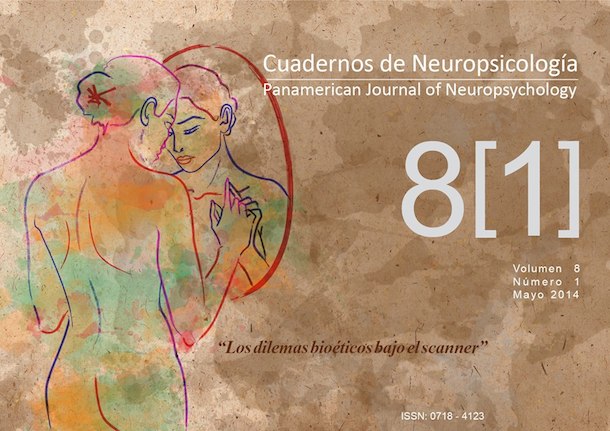Evaluación de componentes implicados en la Función Ejecutiva en niños de 9 años / Assessing Executive Function components in 9 years old children
Abstract
Resumen
La función Ejecutiva (FE) es un constructo teórico multidimensional, definido como el conjunto de actividades que permite realizar de manera eficaz conductas con un propósito, dirigidas a una meta. El objetivo de este trabajo es explorar algunas de las habilidades cognitivas que constituyen un factor común de funcionamiento ejecutivo en una muestra de niños de 9 años. Para ello se trabajó con 101 sujetos de ambos sexos, pertenecientes a escuelas privadas de la Provincia de Buenos Aires, Argentina, a quienes se administró la BaterÃa de Evaluación Neuropsicológica de la Función Ejecutiva en niños (ENFEN), compuesta por cuatro tareas: Fluidez (semántica y fonológica), Senderos (gris y color), Interferencia y Anillas, además de la tarea de DÃgitos hacÃa atrás del WISC-III. Inicialmente se realizó un análisis factorial confirmatorio, que no arrojó buenos Ãndices de ajuste, siendo Control Inhibitorio (medido por la tarea de Interferencia) la variable con menor carga factorial y no significativa. Se realizó entonces un segundo análisis en el que se excluyó dicha variable, y se encontraron excelentes Ãndices de ajuste. Los resultados permiten concluir que a esta edad, la FE estarÃa compuesta, en parte, por las siguientes habilidades cognitivas: Fluidez Fonológica y Semántica, Atención Sostenida y Selectiva, Planificación y Memoria de trabajo, pero no asà por el Control Inhibitorio.
Palabras clave: Función Ejecutiva; Análisis Factorial Confirmatorio; Niños; ENFEN
Â
Abstract
Executive Function (EF) is a multidimensional construct. It includes a set of abilities that allows to execute actions with a purpose, aimed to a goal, in an efficient way. The objective of this work is to explore some of the cognitive abilities that constitute a common factor for EF in 9 years-old children. The chosen instruments: BaterÃa de Evaluación Neuropsicológica de la Función Ejecutiva en niños (ENFEN) (Battery of Neuropsychological Assessment for Executive Function in Children), along with the Backward Digits Subtestfrom the WISC-III, were administered to 101 children from private schools of Buenos Aires State, Argentina. The ENFEN consists on EF tasks, including Phonological and Semantic Fluency, Trail Making Test versions for children (gray and colored sets), Interference Task, and Planning disc movements according to a model. An initial confirmatory factor analysis didn’t show significant fit indexes, being the Inhibitory control the variable with the lower and non significant factorial weight. A second model excluding the Inhibitory control measure was conducted, and it showed excellent fit indexes. Therefore, it can be concluded that at this age, some of the cognitive abilities included on the EF are: Phonological and Semantic Fluency, Sustained and Selective attention, Planning and Working memory; which is not the case for Inhibitory Control (measured by the Interference Task in the ENFEN).
Key words: Executive Function; Confirmatory Factor Analysis; Children; ENFEN.
Downloads
Published
How to Cite
Issue
Section
License
Articles published in this journal are protected under the Creative Commons Attribution-NonCommercial-ShareAlike 4.0 International (CC BY-NC-SA 4.0) license. This means that authors retain full rights over their research and publications at all times. As a journal, we fully respect and promote the principles of open access established by this license, allowing the work to be shared, adapted, and distributed for non-commercial purposes, provided that appropriate credit is given to the authors and any derivative works are licensed under the same terms.
Authors are responsible for obtaining the required permission when they wish to reproduce part of the material (figures, etc.) from other publications.
Likewise, CNPs allows authors to host in their personal sites or other repositories that they deem convenient the Final and Definitive Version of the published article with the format assigned by the journal. In no case do we allow access to preprints of the article under evaluation or already published.
When submitting an article to CNPs you are aware that all the contents of CNPs are under a Creative Commons License. In which it is allowed to copy and share the contents freely, always making reference to the origin of the publication and its author.





